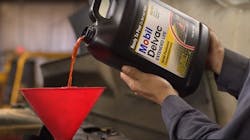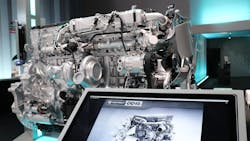The fields along America’s highways once covered in frost are now fully sprinkled in morning dew, indicating spring has sprung and summer is on its way. Soon, sweltering heat will pour down from the sun, heating the road ahead into a mirror. In such conditions, a truck driver may retrace his or her pre-trip inspection routine, recalling if the radiator hoses and coolant level had been checked. The last thing any driver wants is to deal with an overheating engine pulled alongside the molten median, waiting for roadside assistance to arrive.
But with modern engines and connected fleets, is this still a valid concern?
Unfortunately, the best laid plans of OEM engineers and telematics coders can be undone by oversights in the garage or yard, so the answer is a resounding “yes.”
“Failure to properly maintain the cooling system, especially during the summer, can cause the engine to overheat and could cause catastrophic engine damage,” advised Homer Hogg, director of technical service for TravelCenters of America (TA). “In my experience, most cooling system related breakdowns are a result of poor maintenance practices.”
While TCA does not specifically collect data on the subject, Hogg, a veteran technician with nearly 40 years of experience, said engine manufacturers concur that about half of all premature engine failures are the result of improper cooling system maintenance.
This has been a pervasive problem throughout the decade. In 2012, WIX Filters research found a lack of proper cooling system care caused 53% of premature engine failure.
Specifically, for on-highway applications, coolant system problems cause 40% of roadside breakdowns, said Paul Cigala, commercial vehicle lubricants applications engineer for ExxonMobil.
Hogg said trucks with stop-and-go duty cycles are more susceptible because of the added load of a more frequently shifting transmission, which is also cooled by the radiator.
“Additionally, the twisting and turning of the engine in the frame keeps the radiator and hoses moving, which exposes them to more stress and the possibility of fractures,” Hogg added. “The engine is also working harder, which requires the cooling system to step up to the plate and keep the extra heat load under control.”
Unseasonal temperatures
Primary reasons for the high level of seemingly preventable breakdowns include fleets not having a proper maintenance program in place for cooling systems, as well as not leveraging extended life coolants, which have been available for more than 20 years.
The onus ultimately falls on the fleet owner. And while the warmer summer weather may remind a fleet to think more about the engine temperature, the key is to monitor a truck’s diesel engine year-round.
“The maintenance program should be in place all year long,” said Cigala, who started as a lab technician at Mobil in the late 1980s. “Winter can be just as hard on a cooling system as the summer.”
So while June, July and August may increase a person’s barbecue intervals, cooling system maintenance should remain consistent.
“Hot weather maintenance checks should be the same as the rest of the year,” said Dan Holdmeyer, industrial and coolants brand manager for Chevron. Like Hogg, the training specialist also has about 40 years in the coolants industry.
“From a coolant system point of view, maintenance is not much different [in the summer] except that it is even more critical to maintain the radiator pressure cap,” he added. “The pressure cap raises the coolant system pressure above atmospheric [pressure], which raises the boiling point of the coolant.”
The proper coolant system pressure is 15 psi, which increases water’s boiling point from between 212 to 226 degrees F to about 260 degrees F. A loose cap would reduce the pressure and lower the boiling point. The water in the coolant-water mixture, which does the heavy lifting in the heat transfer, would boil away, leaving the system vulnerable to excess heat.
That’s just one thing that can go wrong, but it is a relatively easy thing to fix. It’s also a clear reason why every fleet should have a comprehensive cooling system preventive maintenance plan in place.
When developing a plan, the first thing to understand is that while coolants have changed drastically over the decades, with different colors and additives and dilutions, the issues they solve have remained the same.
The coolant
Back when Holdmeyer’s career began, he said concerns with coolants included depleted additive levels that allowed corrosion, cavitation of liners, and pump failures. And overheating was always a looming threat if proper care was not taken.
“Coolant developed protective salt layers in the coolant system that would protect the metals but would also reduce heat transfer rates,” he explained, regarding previous generations of coolants.
Heat transfer is simply moving stored heat from one medium to another. In a diesel truck’s case, the coolant absorbs and carries excess heat away from the internal combustion engine where it is generated to the cabin heater and/or radiator. Just as seamlessly timed combustion cycles are critical to efficiently power the engine, optimizing the exchange of heat from one part of the system to another is vital to keeping the various components operating as they should.
“Engine coolant systems have gotten more complex, not only with many more components requiring heat regulation, but also adding many different metals and seals,” Holdmeyer said. “Coolants must be compatible with—and protect—these materials.”
There are several components in the process, including the radiator, thermostat, water pump, and water jacket that envelopes the engine. This required coolant formulations to change as well.
“Twenty-five years ago, extended life coolants (ELCs) were introduced, which greatly improved coolant heat transfer and ease of maintenance,” Holdmeyer said.
“We just can't do enough getting the word out on coolants,” said Stede Granger, OEM technical services manager for Shell Lubricants. “My No. 1 recommendation is to follow the directions.”
Generally, this means using the right type of coolant for the engine and application. The first thing to look at is the dilution. Typically, in the United States, this will be a 50/50 mix, which refers to 50% ethylene glycol and 50% distilled or deionized water. In Alaska and Northern Canada, a 60/40 mixture may be used due to the need for more ethylene glycol, commonly known as antifreeze.
Granger recalled when Shell Rotella introduced ELC two decades ago, with Ryder and Penske among the first large fleets to specify this coolant type. These types of coolants can last at least 600,000 miles (or 12,000 hours) and improve total cost of ownership by reducing water pump failures, hard-water-scale deposits and silicate gel.
“One of the things that it really does well is it keeps the cooling systems clean and keeps heat transfer surfaces in like-new condition,” Granger said, of ELCs.
Additives are used to achieve these benefits by coating the metal components. Understanding how these additives interact with current equipment is crucial.
Nitrites protect the cylinder sleeves from cavitation-corrosion, or pitting. Harmonic vibrations in the engine can shake the coolant vigorously enough to create vapor bubbles, which explode and eventually erode the metal surface and decrease performance.
One issue is that nitrites deplete over time and become less effective, requiring more vigilance in keeping a proper coolant level. The other issue is that OEMs have moved to more lightweight aluminum components, primarily in the radiator and heater core. Nitrite-free OAT coolant formulations have been developed to address these needs.
“Nitrite is not aluminum friendly under certain conditions,” Granger explained. “Under certain conditions you can have a very adverse aluminum nitrite reaction that can actually create ammonium in the coolant. In some extreme cases, this can cause significant damage to the aluminum heat exchanger, even causing a leak.”
Coolant does require top offs on occasion, and on the road, getting the right coolant may prove difficult. Rotella released an ELC Correction Fluid that will restore the proper additive content to the system, which can be kept in the can or added back at home base.
Acustrip developed a pass/fail diagnostic test strip that indicates if the additive level is below 80%, the level at which coolant performance degrades. If it is below this level, an additive booster should be used.
Engine
The coolant has many jobs, including carrying heat to the cabin heater and cooling the transmission, but the major job is in the engine, “channeling heat where it should be and away from where it shouldn’t,” surmised Michael Young, marketing manager for Detroit Diesel (DD) engines.
He said engineers designed the DD15, the factory powertrain for the Class 8 Freightliner Cascadia tractor, to operate under a consistent temperature regardless of ambient temperature.
Young explained that looking at a thermal map of the cylinder cross-section would reveal very few areas run hotter than others. The coolant passes through the cylinder liners, then goes up into the head gasket and exhaust gas recirculation (EGR) cooler before returning back to the radiator.
“If you don’t have that coverage, you can get pitting or cavitation,” Young said. “With those heat variances you can have metal expanding and contracting, leading to failures.”
One major change since 2009 was switching from a mechanical water pump to a clutch-controlled viscous one. This reduced parasitic loss or amount of energy sucked from the engine and improved efficiency.
Young said this saves 50 horsepower, which can go back into the engine for power or to save fuel economy.
The Detroit Connect platform has also helped engineers glean data, make adjustments and discover superfluous parts to remove in future iterations of vehicle designs, such as the coolant filter.
Engine telematics data also provides fleets extra visibility into possible air flow problems that could decrease the system’s performance, setting priority levels to let drivers know if they should have the vehicle checked immediately or if it can wait for an upcoming maintenance interval.
The DD15 Gen 5, due out in 2021, will have some incremental improvements based on production insights since the Gen 1 released in 2009. A big part is getting more heat to the aftertreatment system.
To improve efficiency, the team improved pressure flow at the end of the line and simplified parts.
“The more you can reduce moving parts and connections, you can reduce the issues coming up,” Young said.
Emissions aftertreatment system
While engine system cooling is a year-long commitment, hotter ambient temperatures can exacerbate problems with keeping an even heat distribution. This has become more complex since emissions regulations have necessitated the addition of diesel particulate filters (DPFs), selective catalytic reduction (SCR) and EGR technologies.
“Internally generated heat is probably more of concern that is made worse by higher external temperatures,” Holdmeyer said. “It is more important than ever to keep the coolant system in optimum condition.”
He called out EGR valve failure as a particular area to monitor. If the EGR overheats, coolants will degrade more quickly, and less exhaust emissions will be removed. A check of the coolant pH, which can be done when verifying concentration, and discovery of low levels may indicate a faulty EGR valve.
The diesel exhaust fluid, which must be hot enough to burn particulates, is heated by the coolant.
“We absolutely want more heat to go back down from the turbo(charger) and towards the exhaust to keep temperatures up, because the more you keep temperatures up, the less ash and soot accumulate,” Young said of how Detroit Diesel manages the heat exchange.
Fleet perspective
Brent Higgins, owner of Brent Higgins Trucking in Mulberry, Ark., runs a fleet of 22 Freightliner Cascadias with DD13 or DD15 engines, and specializes in refrigerated transport.
This fleet maintains the cooling system throughout the year and has rarely had an overheating issue. On those rare occasions, the issue is a damaged or broken hose that caused the coolant to leak.
The heat may not be as much of a problem as the humongous bugs that thrive in the humid Southern Ozark region are.
“When bugs hit the mesh, the bug juice splatters on the radiator—and it’s sticky,” explained Higgins. “You drive through dust and it sticks. There's a thin layer of insulation now holding that heat in, keeping that air from cooling the radiator tubes.”
Twice a year, Higgins’ maintenance team, led by his son, Dillan Higgins, blows out the radiator to clean the system and ensure heat exchange occurs as intended.
One recurring issue the fleet has had to deal with is cracking coolant reservoir tanks. This is where excess coolant resides until the thermostat lifts and the liquid can enter the system.
During preventive maintenance inspections, five of these tanks were found to have been cracked.
Daimler Trucks North America, parent company of Detroit Diesel, said this was not known to be a pervasive problem and is following up with Higgins to discover the root cause.
It’s one relatively small problem for one small fleet, but if left unchecked, could have disastrous consequences.
“If the leak was not tended to the reservoir would start letting a lot of coolant out and the truck would have to be towed,” Dillan said. The minimum bill for such a roadside breakdown would be more than $1,000 for the tow, parts and labor. On top of that, the company would have to pay a driver detention and late delivery fees.
To avoid the risk, all reservoir tanks are changed at 400,000 miles, because the cracked tanks had each accrued 450,000 miles.
Each fleet will have its own unique circumstances based on coolants, engine, application and region, but the common thread is to remain vigilant so it’s not your driver sweating on the side of the road due to some uncool maintenance routines.







